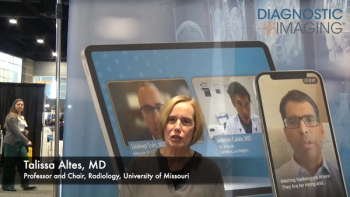Facilitating Efficiency with a Proactive Approach in Radiology
Exploring ways to bolster efficiency in an ongoing manner can help mitigate the strain of burgeoning worklists and improve morale.
Long before I even knew the word, I was all about efficiency. It was instinct. If I am doing something, I want to do it as well as I can, expending as little effort or other resources as possible. Call me lazy if you want to focus on the low-effort part, but does that matter if I do a good job?
Before you can get efficient with something, you first have to learn how to do it at all. I found some efficient maneuvers during the years I spent in radiology residency and fellowship, but my main focus then was absorbing vast amounts of info while juggling a hefty work schedule. One tries to reliably stay afloat before mastering water ballet.
Even my first couple of years out of training were mostly about meeting basic expectations rather than shooting for the moon. In my first job, I did well just to put a dent in their chaotic week-long backlog of cases. In my second gig, I was able to stay ahead of the curve without much effort. I felt no pressure to “work smarter, not harder.”
Subsequently joining my first (and biggest) telerad outfit, suddenly there was efficiency everywhere. It had to be the case. The entire biz worked on the premise that you read cases for a fraction of their value, but you had enough tools and tips that you could make it up on volume.
One of my favorite efficiency tools was a dictation headset. In training and my non-telerad jobs, we had handheld dictaphones or a touchtone phone transcription service. That tied up hands, tethered us with limited lengths of cord, and added to the number of devices that, if not functioning properly, could leave us dead in the water.
A headset freed up the hands allowing manipulating of the mouse, keyboard, or other image manipulation devices. It plugged directly into the workstation, making it part of a one-stop gizmo shop. This added other great features such as voice commands for additional software control for example. It also enabled a VOIP phone so I would never have to reach for the old handset again. If someone called me, I would seamlessly transition from dictating to talking to that person.
It was such a great boost that I couldn’t see how anybody would want to work without one. Of course, they did. Other rads still used handheld dictation wands and goose neck mics standing on their desks. It was hard not to feel like they were needlessly hamstringing themselves, but it would be pretty self-centered not to allow that they might have good reasons for doing things their way rather than mine.
Yet when I moved on to subsequent telerad gigs with smaller entities, I often found myself on the other side of that equation. Any time a rad group or hospital was about to send me a workstation, I had to ask in advance if they would be able to include a headset. Sometimes the concept was so far off their radar that I had to do some convincing and explain why I found it superior. In the worst-case scenario, I would play the temperamental artist card. If you want me doing my best work, give me this thing I find important. You don’t even need to understand my motivation.
It wasn’t entirely their fault. More than a couple of times, the IT people behind their workstations, software, etc., didn’t even have a headset on their “approved” list of compatible devices. It wasn’t that they had gone through all commonly available headsets and found conflicts. They (or the companies behind their vendors) hadn’t even tried any. My solution was usually to just plug in a headset that I liked and hope it worked...which was usually the case.
A variation of that scenario just played out in my current gig. Dictation software was upgraded, and suddenly I was having a bunch of issues with lagging, freezing, etc. They tinkered with settings. They uninstalled and reinstalled the software. You name it but none of this helped. Finally, one mentioned that my headset was not on the approved list but at least this time, there was a list of some, and he had a few sitting around. A FedEx shipment later, I plugged in and all my troubles vanished.
I am not sponsored by the voice-rec company in question and won’t ballyhoo the company’s name here, but the company did something that should be more widespread in our field. When you have a worsening shortage of rads and are constantly on the lookout for ways to boost their efficiency, it is worth proactively doing things that might suit any rad who hypothetically uses your product, joins your team, etc.
In other words, don’t wait until a rad you have never imagined (someone who likes using headsets for instance) comes out of the woodwork and can’t seamlessly mesh with your system. Develop and test products. Figure out protocols for managing workflow. Whatever the case, try brainstorming about rads with preferences or styles that you haven’t thought about before.
Easier said than done, right? It’s trying to catalog your “unknown unknown.”
Rather than relying purely on your own imagination to inform you of chinks in your armor, it is good to keep ears open for the experience of others in your field. Someone reading this, for instance, might realize that they have never checked to make sure their system has at least one tested/approved dictation headset. They might kick off an initiative to make sure that they will have an answer if/when a rad like me crosses their path.
Radiology social media is a goldmine for seeing other folks’ logistical challenges and vicariously learning their solutions. If I read about a rad who, for some reason, just cannot get voice recognition to work for him or her, but does superb and/or voluminous work when plugged into a human transcription service, I might look into options for such services myself. In case I ever find myself wishing I could hire such a rad, I will have some idea regarding feasibility.
At the very least, having a flexible, versatile system is a great safety net. Whatever unforeseen issue comes up, an ability to roll with the punches and figure out how to adapt is a lot more likely to bring success than stonewalling. “We have always done things this way and won’t change unless we’re forced to” leaves a lot of opportunities on the table for someone else to scoop up.
Newsletter
Stay at the forefront of radiology with the Diagnostic Imaging newsletter, delivering the latest news, clinical insights, and imaging advancements for today’s radiologists.





























